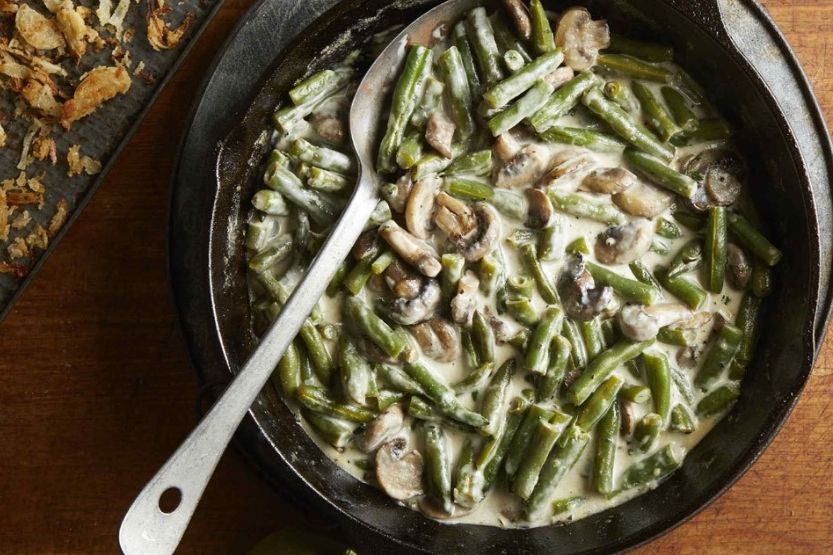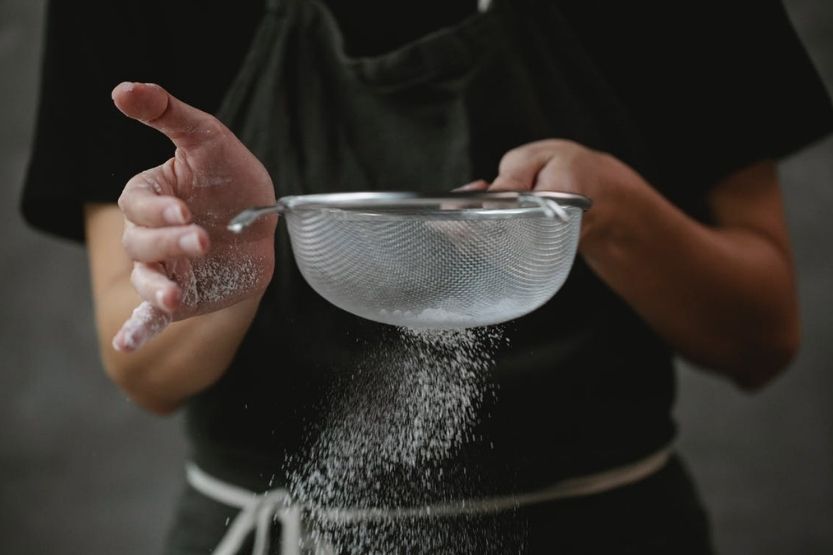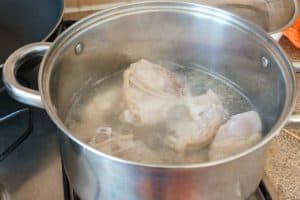Putting together and baking a casserole in the oven is pretty simple. However, there are times that it gets too liquidy. In this article, I’ll give you information that will help you when your casserole is runny and watery – how to fix it.
If your casserole is runny and watery, you can fix it by whisking together equal parts of cold water and cornstarch in a small bowl. Add one tablespoon of cornstarch for every cup of liquid you want to thicken. Stir out every lamp to make it smooth. Before the casserole is cooked, add a small amount of this mixture until you get the desired consistency.
One of the reasons your casserole gets so watery is that the recipe has so many raw vegetables. The natural juices from these raw veggies are released while cooking the casserole. That makes the dish very liquidy.
Read on to learn more about runny and watery casserole and how you can fix it.
Casserole Is Runny and Watery

Too Many Raw Vegetables in the Dish
Casseroles are pretty simple to cook. However, there are times when the casserole you are baking gets watery and runny. That’s because you have used too many raw vegetables in the dish. The natural juices of these veggies are released while cooking the casserole, making it runny and liquidy.
Add a Slurry
To fix a watery casserole, you need to add a mixture of cornstarch and water in a small bowl. The mixture is one part cornstarch for every cup of liquid you would like to thicken.
Whip these two ingredients and stir all lumps. Then before the casserole is fully cooked, add small amounts of this mixture until you get the thickness or consistency you desire.
Your casserole will get liquidy if you use too many raw vegetables in your recipe. Raw veggies like squash, zucchini, spinach, onion, eggplants, and mushrooms will release their natural juices while they are cooking. So, your casserole will become runny or watery after it is done.
There are many ways to fix a watery casserole. The most common fix to a runny casserole is whisking cornstarch with water to make a slurry.
Stir the Dish
Then stir this mixture, and add a small amount at a time into the dish while cooking it. It is wrong to add flour directly to the casserole since it will form clumps.
Bring the Dish to a Boil
After you’ve added the slurry, bring the dish to a boil. The cornstarch will be cooked, which will cause the starch’s swell. Hopefully, your casserole will lose its runny and liquidy characteristics.
Other Ingredients You Can Add to Thicken the Casserole
You can also make different kinds of slurries to bind your casserole and make it thicker. Some of the ingredients you can use to make slurries include:
- Canned tomatoes,
- Cheese sauce,
- Eggs, and
- Certain low-fat dairy products.
These different varieties of slurries can change the texture of your casserole and prevent it from getting ‘soupy.’ The rest of this article will give you the different ways you can fix your casserole if it is runny and watery.
How to Fix Runny and Watery Casserole
1. Remove Excess Liquid
After you have cooked your watery casserole, strain its excess liquid. Pour the liquid broth in the dish into a dish or bowl after it is done. To do this correctly, place a lid over the casserole plate. Then pour the liquid through the slit. Try not to touch the other ingredients of your casserole.
You don’t need to get rid of all the casserole’s liquid. You can pour it inside a pot and simmer it on medium heat so the liquid will evaporate. That will thicken the liquid. If you want, you can add it back to your casserole.
Before reducing the liquid from the casserole, remove large pieces of meat and vegetables first, if possible. If you don’t, they will get overcooked and hinder the removal of excess liquid.
2. Leave the Casserole in the Oven
If there’s not much liquid in the casserole, but you still want to lose its runny and watery condition, leave it inside the oven after it is done.
The remaining heat inside the oven will do the thickening work for you. This might not take more than 5 to 10 minutes, and you’ll get your desired casserole consistency.
But before you do this, be sure that the other ingredients in your casserole can take the extra cooking time. The dish’s vegetables may get overcooked or burned if you leave the casserole in the oven longer.
3. Allow the Casserole to Cool Down
If your sweet potato casserole is runny, let it cool down after taking it out of the oven if you will not eat it right away. As it cools down, the casserole will thicken on its own. This is the best way to thicken a watery casserole.
After it cools down, you can put it in your fridge to make it more solid before eating it.
However, if your casserole is already thick the way you want it and you have leftovers, you need to add a little water or broth before putting them inside the fridge. The extra liquid will soften them and not make them overly thick.
4. Use Cornstarch
Another way you can thicken your casserole is by making cornstarch slurry. This is an easy and fast way to solidify your watery casserole. Whip together equal parts of cold water and cornstarch in a small bowl.
Then use one tablespoon of this slurry for every cup of liquid you want to thicken. Be sure to stir out all the lumps so the mixture will be smooth. Add this slurry in small amounts, just a few minutes before the casserole is cooked. Then allow the dish to cook thoroughly.
If your corn casserole is runny and you want to improve its flavor, you can use chickpea flour instead of cornstarch to make the slurry. This type of flour makes for delicious casseroles.
5. Add Flour

Another popular way to thicken a watery casserole is by using flour. After you have browned your meat ingredients and before you add any liquid, put some flour into the cooking pan.
The flour you add will soak up the fat and juices in the pan. Just add one teaspoon of flour until you get your desired thickness.
Another way of using flour is to make a roux with equal parts of flour and butter. Put the butter first on the pan over medium heat until fully heated. Then while whisking the butter, slowly add the flour.
Continue whisking the flour and butter from two to three minutes after adding all the flour. Mix this paste with the liquid base of the casserole before you add it to the main casserole dish.
About one ounce of flour and one ounce of butter will be enough to thicken a pint of liquid. If you’re a vegan, you can use vegetable oil instead of butter.
6. Make a Beurre Manie
A beurre manie is somewhat like a roux, but it is not done by cooking. You can make a beurre manie by whisking equal parts of flour and butter together. After mixing these two ingredients, you need to roll the thick paste into small balls shaped like small teaspoons.
To thicken your casserole, you need to add one ball at a time. Then wait one minute before adding another ball. Repeat doing this until you get your desired casserole thickness. If there are leftover balls after your casserole is done, put them inside the freezer so you can use them later.
7. Use Arrowroot Powder
Another way you can correct your watery casserole is by using arrowroot powder. If you avoid dairy products like butter, you can use this powder. While cornstarch mixes well with butter, arrowroot powder does not but is also effective as a thickener for dairy-free dishes.
8. Add Cornflour
Cornflour is an alternative to the common flour that is used for baking. You can combine one teaspoon of cornflour with one tablespoon of water at room temperature.
Add this paste to your casserole and bring it to a boil. Keep on cooking the casserole until it acquires the thickness that you want.
Cornflour is gluten-free, so this alternative is great for gluten intolerant people. This flour type is somewhat gelatinous. So be careful to add only a teaspoon of it so that your sauce will not turn goopy.
9. Use Chia Seeds
You can use some seeds and nuts to thicken watery casseroles. An example is chia seeds with great nutritional contents like fiber, omega-3, protein, B vitamins, calcium, magnesium, and phosphorous.
Mix one tablespoon of these seeds with 1/3 cup of water. Let the paste stand for about 15 minutes. When it solidifies, slowly add it to the casserole just before it is finally baked in the oven.
Again, how do you fix a casserole that is too watery and runny? To thicken your watery and runny casserole, you can add starch, flour, nuts seeds, or lessen the casserole’s liquid.
10. Add Cashew Nuts
Using cashew nuts will give your casserole a smooth, creamy consistency. They are suitable for thickening vegan casserole recipes. For every cup of casserole liquid, you need to put in around 1/4 cup of cashews.
In preparing the cashew nuts, soak them in water overnight and place them inside the fridge. Then drain the water and put the nuts in a blender to turn them into a soft paste. Add the paste directly to the casserole before baking.
11. Use Flax Seed
Flaxseed is another good alternative to flour for thickening casseroles. These seeds are effective in absorbing water fast. Only a small amount is required to achieve the thickness that you want. You can buy ground flaxseed at your local store.
If you are using real flax seeds, you need to prepare them. Just grind them in a coffee grinder or food processor. Then add small amounts directly to the casserole before it is finished cooking. You need to add one tablespoon of flaxseed for every cup of casserole liquid.
12. Add Vegetable Puree
You can also use starchy vegetables to solidify your watery casserole. They are great thickening substances. Celeries, winter squash, and potatoes are some examples of starchy vegetables. Just roast or boil these veggies and put them inside a food processor until they become smooth like a paste.
Mix them into the sauce, and your casserole will quickly get thicker. Cooked lentils or beans or steamed and mashed cauliflower are also great alternatives. Keep in mind that they will also add their flavors to your casserole.
13. Use Tomato Paste
You can also use tomato paste to thicken your casserole. To get the best result, you need to add this paste as you start to combine all the casserole ingredients. If you add it during the cooking process, you will release its essential oils, and it will caramelize its sugars.
The best way is to add it near the end of the baking process. This will allow the casserole sauces and the tomato paste to bind effectively.
14. Add an Egg Yolk
The yolk of an egg is very effective in thickening custards and salad dressings. You can also use it to solidify your runny casserole. But you need to prevent the egg yolk from scattering or scrambling.
So, place the egg yolk in a small bowl. Then slowly whisk in around one cup of the hot sauce. Then add this mixture to the casserole dish by whisking it.
15. Use Butter
You can use butter if you want an extra boost of thickness to your green bean casserole. This will help you get the desired consistency.
Just swirl a pat of butter into the sauce at the end of the baking process. If you do it sooner, the butter-infused sauce will break because of the exposure to high heat. This will not help in thickening the casserole.
Thick and Non-Watery Casserole Recipe

You will better appreciate the subject matter of this article if I will give you a recipe for a thick and non-watery casserole. In this regard, here is a zucchini lasagna recipe. It uses the layering technique.
Ingredients
The ingredients of this recipe are the following:
- Zucchini
- Ground beef
- Pasta sauce
- Ricotta cheese
- Parmesan cheese
- Mozzarella cheese
- Egg
- Basil
- parsley
Steps
- Slice the zucchini lengthwise
- Make the Bolognese sauce in a big cooking pan over medium heat.
- Cut down the beef into small pieces and cook until they are browned.
- Stir in the pasta sauce.
- Make the ricotta cheese mix by combining the ricotta, parmesan, egg, and small amounts of salt and pepper.
- Spread 1/2 cup of the pasta sauce on the bottom of the casserole pan or dish
- Put the zucchini slices above the pasta sauce.
- Add 1/2 of the bolognese sauce and then spread 1/2 of the ricotta cheese evenly on top of it.
- Sprinkle 1/2 of the grated mozzarella cheese together with some chopped basil and parsley
- Add a layer on top of all these ingredients by repeating steps 6 to 9
- If you want, you can press down on the zucchinis on the second layer to get your casserole flat and pretty
- Sprinkle herbs and 1/2 cup of grated mozzarella on the top layer
- Put the casserole in the oven and bake it for around 40 minutes.
- Allow the casserole to broil for an extra 5 minutes more so that its top will get golden brown.
- Garnish the casserole with whole basil leaves and serve.
Frequently Asked Questions
Here are some answers to the most often asked questions on how you can fix a runny and watery casserole:
How Can You Fix a Runny and Watery Casserole?
The most common fix to a watery casserole is to use cornstarch. You need to mix equal parts of cornstarch and cold water. Use one tablespoon of this mixture or paste for every cup of liquid you want to thicken.
See to it that all lumps are stirred well. Just before your casserole is fully cooked, add this paste a small amount at a time until you get the thickness that you want.
What Causes a Casserole to Be Watery?
Your casserole becomes runny and liquidy if it is full of raw vegetables. When veggies are being cooked, they release so many natural juices. So, you have to use just the right amount of watery veggies if you want to bake a thick casserole.
Are There Other Ways You Can Thicken a Runny Casserole?
Yes, there are several ways you can solidify a watery casserole. You can use the following ingredients:
- Flour
- Corn flour
- Cashew nuts
- Flax seeds
- Chia seeds
- Tomato paste
- Butter
- Egg yolk
You can also reduce the watery content of the casserole by leaving it in the oven after it is fully cooked. Turn off the oven, but leave the casserole inside. Hopefully, the remaining heat inside the oven will cause the extra moisture in the casserole to evaporate.
In Closing: Fixing a Runny and Watery Casserole
The most common fix to a runny and watery casserole is adding a mixture of cornstarch and water. Mix equal parts of these two ingredients in a small bowl. Just add one tablespoon of this cornstarch paste for every cup of liquid you want to thicken.
Stir out every lump in the mixture so it will be smooth. Just shortly before the casserole is done, add a little amount of this thickener to the casserole until you get the consistency that you want.
Read next:
What Are the Differences Between Olive and Vegetable Oils?



